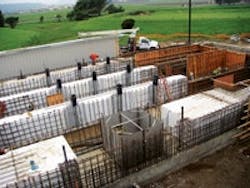About the author: David Shong is a Geofoam technical specialist for Insulfoam, a Div. of Carlisle Construction Materials. Shong can be reached at [email protected] or 253.303.1817.
In one of the top soul songs of the 1960s, Otis Redding crooned, “I’m sittin’ on the dock of the bay, watching the tide roll away.” Keeping that tide clean is no small accomplishment in a body of water surrounded by one of the nation’s largest metro areas with more than 7.1 million residents.
The northeast inlet to San Pablo/San Francisco Bay is the Suisun Bay, which includes Suisun Marsh—the largest contiguous estuarine marsh on the West Coast and a stopping point for 1.5 million migratory birds each year. Discharging to the marsh and the nearby Sacramento-San Joaquin River Delta is treated effluent from Fairfield and Suisun City, Calif., along with Travis Air Force Base.
In 2011, the Fairfield-Suisun Sewer District completed a substantial upgrade of its wastewater treatment facility to ensure compliance with National Pollution Discharge Elimination System (NPDES) permit requirements. The project used engineered, construction-grade expanded polystyrene (EPS) geofoam as an easy-to-place, cost-effective structural void fill for three large concrete water channels and elevated platforms.
Project Summary
Located midway between San Francisco and Sacramento, the Fairfield-Suisun Sewer District collects, treats and recycles wastewater from 135,000 residential, commercial and industrial customers across 41 sq miles of Solano County. Winner of several NPDES permit-compliance awards, the agency upgraded its treatment plant to UV disinfection for its tertiary treatment.
The new 45-million-gal-per-day (mgd) UV disinfection facility includes a channeled concrete structure, metal canopy enclosure, UV disinfection equipment, and power and instrumentation systems. Two new 56-in. and 60-in. steel-reinforced concrete effluent pipelines were installed to incorporate the UV disinfection system into the existing primary/secondary treatment facility.
Foam & Water
On the surface, who would think that a material commonly used in floatation applications—EPS—would have a place in the structure of a wastewater treatment plant? However, in the form of construction-grade, geosynthetic blocks, EPS geofoam now is being used as a lightweight structural void fill in many infrastructure projects, from road and highway sub-base, to levees, to water-handling facilities.
EPS geofoam is approximately 98% air, making it much lighter than other fills. It weighs only about 1 to 3 lb per cu ft—100 times lighter than soil—yet is durable and has predictable, engineered properties. The material has high load-bearing capacities. In fact, as an indication of its strength, geofoam has been successfully used as a sub-base material for pavement sections that bear the live loads of cars, trucks, locomotives and wide-body jet aircrafts. Because of its weight, EPS geofoam blocks are easy for crews to place by hand. Furthermore, because one truckload contains 120 cu yd (equal to 12 dump trucks of earthen fill), it can help reduce construction traffic and transportation costs.
In the Fairfield-Suisun water treatment plant expansion, the project team specified InsulFoam GF EPS15 to fill the voids in the walls of each of the three 7-by-7-by-50-ft concrete water channels in the UV disinfection structure. The unit price of the geofoam was higher than soil fill, but the geofoam was much less labor-intensive to install, without a need for heavy earth-moving equipment in the tight construction site.
Typically, when a compartment channel or elevated platform is constructed, it involves a two-sided forming system that is filled with concrete to create the outer walls. After the forms are stripped, granular soil, sand or concrete slurry typically is filled and compacted between the two stem walls. A second concrete pour then is required to cap the channel with a topping slab. With geofoam, the EPS geofoam blocks constitute half of the form, which simultaneously displaces the void and easily bears the weight of the concrete topping slab. This allows for a monolithic pour of the top and the walls simultaneously, which significantly reduces forming costs and aids concrete pouring schedules.
The manufacturer, Insulfoam (headquartered in Tacoma, Wash.), precut all of the EPS geofoam blocks to size, including the pipe stanchion profiles, at its Dixon, Calif., factory. The only modifications made to the blocks on site were to cut through holes for pipes and conduits that were easily fabricated with a hot wire cutting set provided by Insulfoam. The Kaweah Construction Co. (now part of the W.M. Lyles Co., Fresno, Calif.) installed approximately 90 cu yd of EPS geofoam quickly and easily.
In addition to its use as a structural void fill, another common application for EPS geofoam is soft soil remediation. On sites with soft, compressible foundation soils—such as peat or soft clay—lightweight EPS geofoam helps enable the construction of stable foundations for infrastructure projects. For example, the Alaskan Way Viaduct replacement project in Seattle features approach fill ramps sitting on a tide flat that the city reclaimed with imported fill more than a century ago. To ensure the ramps would not induce settlements on the underlying soils and thereby impact the stability of adjacent elevated structures, contractors used EPS geofoam to provide the necessary load support at a low weight, and eliminated the need to surcharge the soil.
In a similar fashion, the material could be used to create a fully compensated or net-zero load foundation design for water treatment facilities located on river deltas or other soft soils.
A Final Word
After sitting on the dock of the bay for a while, Otis Redding lamented, “Looks like nothing’s gonna change, everything still remains the same.”
At one time in the construction industry, this may have been the case, but more engineers and contractors are reevaluating the age-old materials they have used. Sand and rock, for example, have been the traditional fills since before the Romans built their aqueduct, but advanced engineered materials like EPS geofoam are becoming ever more popular as project teams look for simpler, more effective ways to build.
Download: Here
